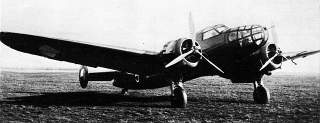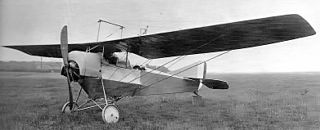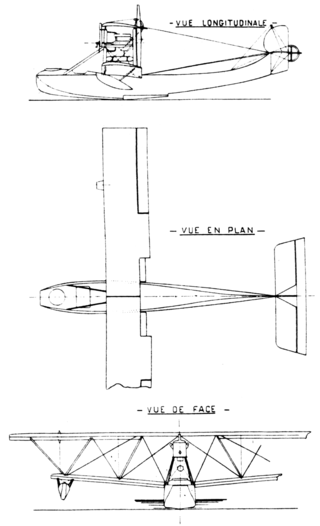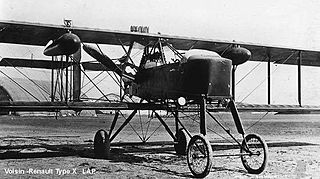Notes
Related Research Articles

The Breguet XIV or Breguet 14 was a French biplane bomber and reconnaissance aircraft of World War I. It was built in very large numbers and production continued for many years after the end of the war.

The Nieuport 17 C.1 is a French sesquiplane fighter designed and manufactured by the Nieuport company during World War I. An improvement over the Nieuport 11, it was a little larger than earlier Nieuports and better adapted to the more powerful engine than the interim Nieuport 16. Aside from early examples, it had the new Alkan-Hamy synchronization gear, permitting the use of a fuselage-mounted synchronised Vickers gun firing through the propeller disc.

The Aero A.14 was a Czechoslovakian biplane military reconnaissance aircraft built in the 1920s. It was essentially a slightly modified version of the Hansa-Brandenburg C.I aircraft, widely-used by Austria-Hungary during the First World War, and for this reason, the aircraft is sometimes referred to as the A.14 Brandenburg. When equipped with a slightly different engine, the aircraft was designated A.15 instead. The two versions were otherwise almost identical.

The Aero A.300 was a Czechoslovak bomber aircraft that first flew in 1938 as a much refined development of the A.304. It was designed by Aero to meet a requirement for a bomber-reconnaissance aircraft for the Czechoslovak Air Force, the Aero A-304 transport/bomber formed the basis for its design. It was a four-seat aircraft powered by two Bristol Mercury IX radial engines. The A-300 was faster than any other Czechoslovak aircraft in the inventory except for the Avia B-35 fighter. Despite showing much promise, development and production of the aircraft was stopped by the German occupation of Czechoslovakia.

The Nieuport 27 was a World War I French sesquiplane fighter aircraft designed by Gustave Delage. The 27 was the last of the line of Nieuport "V-strut" single seat fighters that began with the Nieuport 10 of 1914. Operational examples supplemented the very similar Nieuport 24 and 24bis in operational squadrons in late 1917 and many would also be used as advanced trainers.

The Caudron R.11, was a French three-seat twin-engine long range escort fighter biplane developed and produced by Caudron during the First World War.

The FBA Type H was a French reconnaissance flying boat produced in large numbers in France and Italy during World War I by Franco-British Aviation.

The Salmson-Moineau S.M.1 A3,, was a French armed three-seat biplane long range reconnaissance aircraft of the First World War designed by René Moineau for the Salmson company.

The Letord Let.5 was probably the most numerous of a family of 3-seat reconnaissance bombers, designed and built in France from 1916, originally to an A3 specification from the STAé.

The R.E.P. 'Parasol' Type L was a military reconnaissance aircraft designed and produced in France by Robert Esnault-Pelterie in 1914.
The Borel-Odier Bo-T was a French twin-engined float biplane designed by Borel but built by Antoine Odier for the French Navy.
The Adolphe Bernard AB was a twin-engined French biplane aircraft, built near the end of the First World War. Ten AB 1 BN2 bombers were produced for the Armée de l'Air but did not reach squadron service; post-war, two civil derivatives were considered but only one aircraft was built.

The Voisin Triplanes were large experimental bombers built by Voisin in 1915 and 1916. After unsuccessful trials of the 1915 prototype a modified version with more powerful engines was built in 1916, as the Voisin E.28, but the type did not enter production.
The Voisin VI or Voisin Type 6 was a French pusher biplane bomber aircraft of World War I.
The Tellier T.2 was a French two-seat patrol biplane flying-boat built by Société Alphonse Tellier et Cie à Neuilly (hull) and Voisin (wings). The wooden-hull flying boat used a 150 kW (200 hp) Hispano-Suiza 8Ba engine and was first flown in June 1916.

The Tellier T.3 was a French two-seat patrol biplane flying-boat designed and built by Société Alphonse Tellier et Cie à Neuilly (Tellier) and also produced by Société Anonyme des Établissements Nieuport (Nieuport).

The Nieuport Triplanes were a series of experimental stagger-wing triplanes modified from Nieuport 10, 17 and 17bis biplanes during World War I that were built by Nieuport. The exact number built is unknown, but only three or four are known to have been evaluated by the French Army Aviation and the British Royal Flying Corps (RFC) and Royal Naval Air Service (RNAS). None of the aircraft were superior to the fighters already in service and they were not accepted for production.

The Blériot Bl.73, Bl.74, Bl.75 and Bl.76 were large First World War French biplanes designed and built by Blériot. The Bl.73 was built to the BN.3 three-seat night bomber specification, the Bl.74 was to be a bomber-transport, the Bl.75 Aerobus was to be an airliner, while the unbuilt Bl.76 was intended for the BN.4 four-seat night bomber specification. Aside from the Bl.76, just one prototype was built of each type, with both Bl.73 and Bl.74 prototypes being lost in accidents while on test flights.

The Voisin X was a French two-seat pusher biplane which was built in two versions, one fitted with a 37 mm (1.46 in) Hotchkiss cannon, and the other as a conventional night bomber. Problems with the Peugeot engine in the previous Voisin VIII led to the installation of a new Renault engine of greater power and reliability, but the new aircraft was otherwise nearly identical to the VIII. Despite its obsolescence, it would make up the bulk of front line night bomber escadrilles until the end of the war.

The Paul Schmitt P.S.7 was a French World War I two-seat biplane bomber that dispensed with the novel variable incidence wing used on prior designs.
References
Bibliography
- Balous, Miroslav (2011). "Tellier T.6". Letectvi + kosmonautika. No. 7. Bratislava: Magnet Press. pp. 24–25.
- Borget, Michel (June 1996). "Des coques et des ailes 2 – Alphonse Tellier, constructeur d'hydro-aéro". Le Fana de l'Aviation. No. 319. Paris: Editions Lariviere. pp. 22–35.
- Davilla, James J.; Soltan, Arthur M. (2002). French aircraft of the First World War. Boulder, Colorado: Flying Machines Press.
- Hornát, Jiří (1991). "Tellier T.3 (Tellier 200 HP) Tc.6 (Tellier Canon)". Letectvi + kosmonautika. Vol. 67, no. 2. Prague: Magnet Press. pp. 39/79.
- Taylor, Michael J. H. (1993). Jane's Encyclopedia of Aviation. London: Studio Editions.